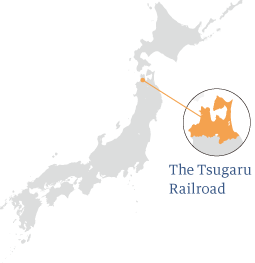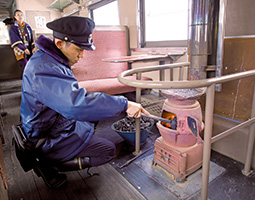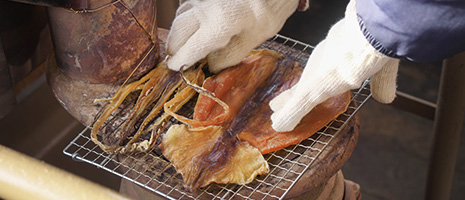- PREVIOUS
- NEXT
February 2020
A Journey to Warm the Body and Soul


The Stove train, which operates in the culturally rich Tsugaru region of Aomori Prefecture, preserves an old-fashioned way to keep passengers warm in the cold winter months.
The Tsugaru Railroad runs through the central part of the Tsugaru Peninsula in Aomori Prefecture on the northern tip of Honshu. The route, which extends 20.7 kilometers from Tsugaru Goshogawara Station in Goshogawara City in the South to Tsugaru Nakasato Station in Nakadomari Town in the North, takes approximately 40 minutes. The Tsugaru Railroad operates seasonal themed trains such as the Furin (Japanese wind chime) train in summer, when carriages are hung with wind chimes made of iconic local Tsugaru Kanayama Yaki pottery, and the Suzumushi (bell cricket) train in the fall, when carriages contain baskets of crickets chirping melodiously. Most famous of all is the Stove train in winter. Featuring coal-fired stoves, the Stove train has been in operation almost every year since the opening of the Tsugaru Railroad in 1930.
“The Stove train was familiar to locals, but since the 1980s it became a popular winter attraction for tourists visiting Aomori Prefecture,” says Tateyama Hiroichi of Tsugaru Railroad Co.
The Stove train makes three round trips a day from December 1 to March 31 every year. Installed in one of the train’s two cars are two pot-bellied stoves, which were widely used in Japan before the popularization of gas and oil-fired heating appliances.

On the Stove train, surume (dried squid and cuttlefish) can be cooked on a grilling net placed on top of a stove. Passengers can bring their own surume, or buy surume produced in Aomori Prefecture on the train. They can also have their surume grilled by the Tsugaru Peninsula Sightseeing Attendant on board. The Stove train operates in the coldest months when the area is covered with snow and outside daytime temperatures on some days drop to around minus 10 degrees Celsius. Chewing on the piping hot, freshly grilled surume while partaking of local sake purchased on the train warms the body and soul.

The train travels at an average speed of around 30 kilometers per hour, allowing passengers to enjoy the views of the vast snowscape. On a fine day, you can see the stunningly magnificent Mount Iwaki with an altitude of 1,625 meters above sea level. Referred to as Tsugaru-Fuji, Mount Iwaki is the symbol of the Tsugaru region.
“Tourists are impressed by the extensive snowfield and the beauty of Mount Iwaki, but when the weather is bad, they are surprised at the ferocity of the blizzards,” says Tateyama.
There are also other tourist spots along the Tsugaru Railroad showcasing the traditional culture of the Tsugaru region. One is Tachineputa no yakata, situated about a 5-minute walk from Tsugaru Goshogawara Station. Tachineputa are giant floats that are carried around the center of Goshogawara City at the Tachineputa Festival, held annually in early August. Neputa Festivals featuring floats with colorful paper dolls depicting warriors and other figures on a dais are held in summer all over Aomori Prefecture. The distinguishing feature of the neputa at Goshogawara City are their great height — 23 meters — compared to floats in other areas. The Tachineputa Museum houses three floats as permanent installations, and visitors can watch tachineputa being made at the production studio. From May to June, visitors can try their hand at pasting paper on tachineputa that will actually be used at the festival.
Another spot where visitors can enjoy traditional culture is the Tsugaru Shamisen Hall in Kanagi Town, about a 10-minute walk from Kanagi Station. Tsugaru shamisen were first produced in the early Meiji period (1868–1912) by a native player of Kanagi Town called Nitabo, who created a style of music played on the shamisen, a stringed instrument that rose to popularity in the Edo period (1603–1867). Tsugaru shamisen is characterized by performances that are rich in improvisation, played at a quick tempo, and have a very loud sound produced by hammering on the strings with the bachi (pick). Visitors to the Tsugaru Shamisen Hall can enjoy shamisen exhibitions and live music.
“Some people come from Tokyo several times a year because they love the people and countryside around here. I would urge you to travel on the Tsugaru Railroad and experience the atmosphere of the good old days in Japan,” says Tateyama.
- PREVIOUS
- NEXT

